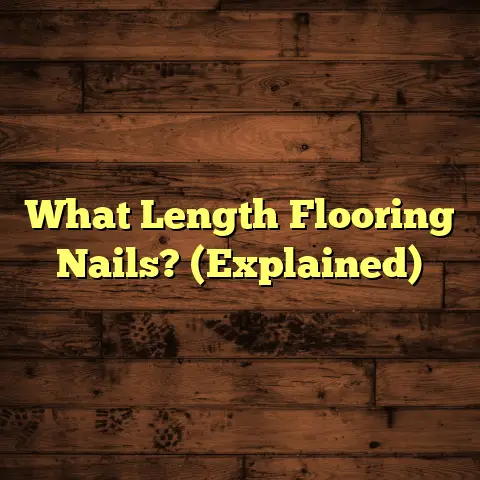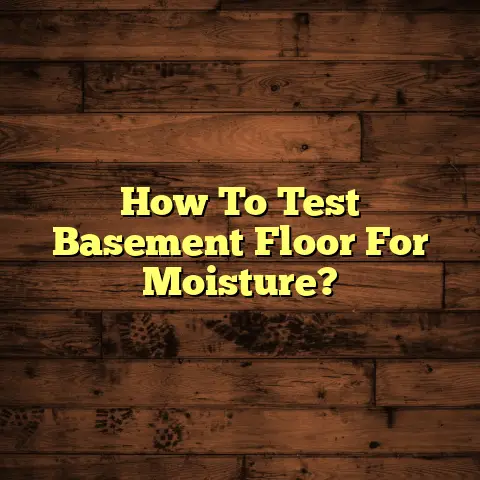Flood Zone Flooring: Best Choices? (3 Options!)
You know, it’s bad when even the ducks start building their own boats! But while we can’t control the weather, we can certainly control how we respond to it—especially when it comes to flooring in flood-prone areas!
Flooding. Just the word sends shivers down the spine of any homeowner, right? It’s not just the immediate damage; it’s the lingering moisture, the potential for mold, and the sheer hassle of cleanup. That’s why choosing the right flooring for homes in flood zones is absolutely crucial.
It’s about more than just aesthetics; it’s about functionality, durability, and peace of mind. We’re talking about flooring that can withstand the worst Mother Nature throws at it, without sacrificing style.
In this article, I’m going to walk you through three of the best flooring options for flood zones, based on my years of experience as a flooring contractor. We’ll dive deep into their pros and cons, and I’ll even share some real-life stories of homeowners who’ve made these choices and lived to tell the tale (and keep their floors intact!).
Section 1: Understanding Flood Zone
Flooring Needs
First things first, let’s get clear on what we mean by a “flood zone.” This isn’t just about living near a river; it’s about areas designated by FEMA (Federal Emergency Management Agency) as having a high risk of flooding.
FEMA categorizes flood zones based on the level of risk. The most common is the 100-year floodplain, which has a 1% annual chance of flooding. There’s also the 500-year floodplain, with a 0.2% annual chance. You can check your property’s flood zone designation on FEMA’s website or through your local government.
Now, why is this important for flooring? Well, homes in flood zones face unique challenges:
-
Moisture: Obviously, flooding brings a lot of water. But even without a full-blown flood, these areas tend to have higher humidity levels, which can wreak havoc on certain flooring materials.
-
Humidity: Continuous moisture exposure can lead to warping, buckling, and delamination in susceptible materials.
-
Mold Growth: Damp environments are a breeding ground for mold, which can cause health problems and structural damage.
That’s where the concept of “resilience” comes in. In the context of flooring, resilience refers to a material’s ability to withstand these challenges without significant damage or degradation. We need flooring that can get wet, dry out quickly, and resist mold growth.
Think of it like this: you wouldn’t wear a paper suit in a rainstorm, right? Same goes for your flooring. You need something that’s built to last, even when the water rises.
Section 2: Option 1 – Vinyl Flooring
Okay, let’s dive into our first contender: vinyl flooring. Now, I know what you might be thinking: “Vinyl? Isn’t that, like, old-school?” Well, think again! Modern vinyl flooring is a far cry from the linoleum of your grandma’s kitchen.
We’re talking about luxury vinyl plank (LVP) and luxury vinyl tile (LVT), which are engineered to be incredibly durable, water-resistant, and stylish. In fact, vinyl flooring is a very popular choice for flood-prone areas, and here’s why:
Pros of Vinyl Flooring:
-
Water Resistance: This is the big one. Vinyl is virtually waterproof, meaning it won’t absorb water or warp when exposed to moisture. This is a game-changer in flood zones.
-
Durability: LVP and LVT are designed to withstand heavy foot traffic, scratches, and dents. Many options come with a wear layer that protects the surface from damage.
-
Variety of Styles: Vinyl flooring comes in a huge range of styles, colors, and patterns. You can find options that mimic the look of hardwood, tile, or stone, without the associated water damage risks.
-
Ease of Installation: Many vinyl products are designed for DIY installation, with click-lock systems that make it easy to put together. This can save you money on professional installation costs. However, I always recommend a professional installation, especially in flood-prone areas, to ensure a proper seal.
-
Low Maintenance: Vinyl is easy to clean and maintain. A simple sweep and mop are usually all you need to keep it looking its best.
-
Affordability: Compared to other flood- resistant options like tile, vinyl is generally more affordable, making it a budget-friendly choice.
Let’s talk about the cost. On average, vinyl flooring ranges from \$2 to \$7 per square foot, depending on the quality and style. Installation can add another \$1 to \$5 per square foot, depending on the complexity of the job.
According to a 2023 report by Statista, the vinyl flooring market in the United States is expected to reach \$12.5 billion by 2027, demonstrating its growing popularity.
Cons of Vinyl Flooring:
Of course, no flooring option is perfect. Here are a few potential downsides to consider with vinyl:
-
Susceptibility to Scratches: While durable, vinyl can be scratched by sharp objects or heavy furniture. Using furniture pads and taking care to avoid dragging heavy items can help prevent scratches.
-
Fading Over Time: Prolonged exposure to direct sunlight can cause some vinyl flooring to fade over time. Using curtains or blinds can help protect your floors from UV damage.
-
Not Always Eco-Friendly: Some vinyl flooring is made with PVC, which is a less environmentally friendly material. Look for options that are made with recycled content or are certified by organizations like FloorScore to ensure low VOC emissions.
Conclusion for Vinyl Flooring:
Overall, vinyl flooring is a fantastic choice for flood zone homes. It offers a winning combination of water resistance, durability, style, and affordability. Just be sure to choose a high-quality product and have it professionally installed for the best results.
Section 3: Option 2 – Tile Flooring
Next up, we have tile flooring. When I say “tile,” I’m primarily talking about ceramic and porcelain tiles. These materials have been used for centuries, and for good reason: they’re incredibly durable and water-resistant.
Tile is a classic and reliable option for flood-prone areas, and here’s why:
Pros of Tile Flooring:
-
Impermeability: Ceramic and porcelain tiles are virtually impermeable to water, meaning they won’t absorb moisture or be damaged by flooding. This is a huge advantage in flood zones.
-
Strength: Tile is incredibly strong and can withstand heavy foot traffic, impacts, and even some minor flooding without cracking or breaking.
-
Aesthetic Versatility: Tile comes in a wide range of styles, colors, sizes, and patterns. You can find options that mimic the look of natural stone, wood, or even concrete.
-
Ease of Cleaning: Tile is easy to clean and maintain. A simple sweep and mop are usually all you need to keep it looking its best.
-
Minimal Grout Lines: Larger tiles can minimize grout lines, which reduces the amount of porous surface area that can absorb water and harbor mold. Using epoxy grout, which is waterproof, is also a great option.
Let’s talk about cost. Tile flooring typically ranges from \$3 to \$10 per square foot, depending on the material, style, and size. Installation can add another \$4 to \$10 per square foot, depending on the complexity of the job.
According to a 2022 report by Grand View Research, the global tile flooring market is expected to reach \$124.5 billion by 2030, driven by increasing demand for durable and water-resistant flooring solutions.
Cons of Tile Flooring:
While tile is an excellent choice for flood zones, there are a few potential downsides to consider:
-
Coldness Underfoot: Tile can be cold underfoot, especially in colder climates. This can be mitigated by installing radiant floor heating, but that will add to the cost.
-
Hardness: Tile is a hard surface, which can be uncomfortable for some people to stand on for extended periods. Using area rugs can help soften the surface.
-
Potential for Cracking: While tile is strong, it can crack if installed improperly or if the subfloor is not level. Proper installation is crucial to prevent cracking.
-
Grout Maintenance: Grout lines can be difficult to keep clean and can be susceptible to staining and mold growth. Regular cleaning and sealing can help prevent these problems.
Conclusion for Tile Flooring:
Tile flooring is another excellent choice for homeowners in areas susceptible to flooding. It offers unmatched water resistance, durability, and aesthetic versatility. Just be sure to choose a high-quality tile and have it professionally installed for the best results.
Section 4: Option 3 – Concrete Flooring
Now, let’s talk about something a little more unconventional: concrete flooring. I know what you’re thinking: “Concrete? Isn’t that for garages and basements?” Well, think again!
Polished or stained concrete is becoming increasingly popular as a flooring option for homes, and it’s a particularly good choice for flood-prone areas.
Pros of Concrete Flooring:
-
Unmatched Durability: Concrete is one of the most durable flooring materials available. It can withstand heavy foot traffic, impacts, and even minor flooding without damage.
-
Water Resistance: When properly sealed, concrete is highly water-resistant. It won’t absorb water or be damaged by moisture.
-
Customization Options: Concrete can be stained, polished, or stamped to create a wide range of looks. You can achieve a modern, industrial look or a more rustic, natural aesthetic.
-
Ability to Withstand Heavy Impacts: Concrete flooring is virtually indestructible, making it an ideal choice for high-traffic areas or homes with pets and children.
Let’s talk about cost. Concrete flooring typically ranges from \$2 to \$12 per square foot, depending on the level of customization and the complexity of the job. Polishing and staining can add to the cost.
According to a 2021 report by Industry Arc, the global concrete flooring market is expected to reach \$48.2 billion by 2026, driven by increasing demand for durable and sustainable flooring solutions.
Cons of Concrete Flooring:
While concrete is a strong contender for flood zone flooring, there are a few potential downsides to consider:
-
Temperature Discomfort: Concrete can be cold underfoot, especially in colder climates. This can be mitigated by installing radiant floor heating or using area rugs.
-
Hardness: Concrete is a hard surface, which can be uncomfortable for some people to stand on for extended periods. Using area rugs can help soften the surface.
-
Need for a Solid Subfloor: Concrete flooring requires a solid, level subfloor. If the subfloor is not properly prepared, the concrete can crack or become uneven.
-
Potential for Staining: While sealed concrete is water-resistant, it can still be stained by certain substances, such as oil or wine. Regular cleaning and sealing can help prevent staining.
Conclusion for Concrete Flooring:
Concrete flooring is a strong contender for flood zone flooring, offering unmatched durability, water resistance, and customization options. Just be sure to have it professionally installed and sealed for the best results.
Section 5: Comparing the Options
Alright, we’ve covered three great flooring options for flood zones. But how do they stack up against each other? Let’s break it down:
| Feature | Vinyl Flooring | Tile Flooring | Concrete Flooring |
|---|---|---|---|
| Water Resistance | Excellent | Excellent | Excellent (when sealed) |
| Durability | Very Good | Excellent | Excellent |
| Cost | \$2 – \$7 per sq ft | \$3 – \$10 per sq ft | \$2 – \$12 per sq ft |
| Installation | DIY-friendly | Professional recommended | Professional recommended |
| Maintenance | Low | Low | Low |
| Aesthetics | Wide variety of styles | Wide variety of styles | Customizable with stains/polishes |
| Comfort | Softer underfoot | Can be cold and hard | Can be cold and hard |
Cost: Vinyl is generally the most affordable option upfront, but tile and concrete can last longer, potentially saving you money in the long run.
Installation: Vinyl is the easiest to install, making it a good option for DIYers. Tile and concrete require professional installation for best results.
Maintenance: All three options are relatively low-maintenance, requiring only regular cleaning to keep them looking their best.
Aesthetics: All three options offer a wide range of styles and colors to choose from, so you can find something that fits your personal taste.
Comfort: Vinyl is the softest option underfoot, while tile and concrete can be cold and hard. Using area rugs can help improve comfort.
Section 6: Real-Life Applications
I’ve seen these flooring options work wonders for homeowners in flood-prone areas. Let me share a couple of stories:
Case Study 1: The Resilient Vinyl Home
I worked with a homeowner in Galveston, Texas, who had experienced multiple floods in her home. She was tired of replacing her carpet and laminate flooring every few years. We installed luxury vinyl plank throughout her home, and she couldn’t be happier.
“The first time we had a minor flood after installing the vinyl, I was terrified,” she told me. “But the water just sat on top of the floor. We mopped it up, and you couldn’t even tell anything had happened. It was a lifesaver!”
Case Study 2: The Durable Tile Oasis
I also worked with a homeowner in New Orleans, Louisiana, who wanted a flooring option that could withstand the humidity and potential for flooding in her area. We installed porcelain tile throughout her home, and she was thrilled with the results.
“I love the look of the tile, and it’s so easy to clean,” she said. “I don’t have to worry about water damage or mold growth. It’s such a relief!”
Conclusion
Choosing the right flooring for flood zones is a critical decision that can save you time, money, and headaches in the long run. Vinyl, tile, and concrete are all excellent options that offer water resistance, durability, and style.
Consider your personal style, budget, and the specific needs of your home when making a decision. And remember, professional installation is always recommended, especially in flood-prone areas.
So, while we can’t predict the weather, we can certainly prepare for it—one floorboard at a time!





